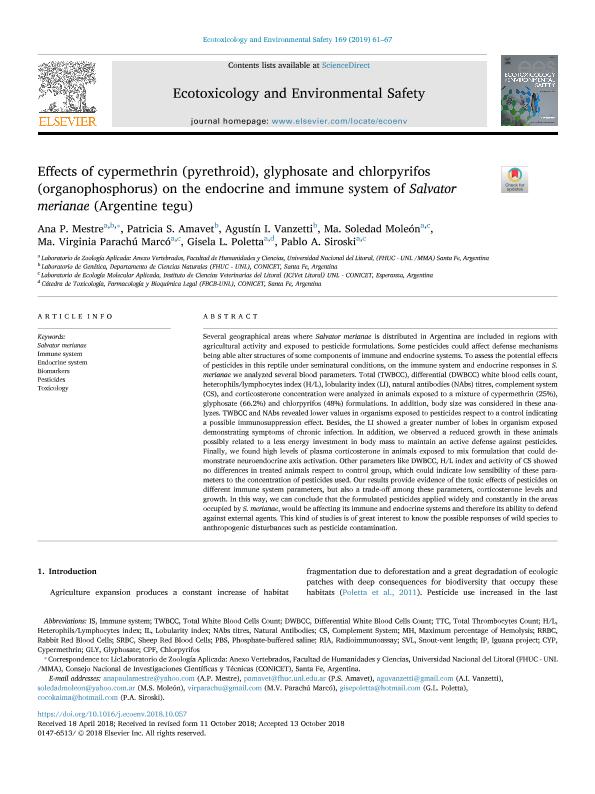Mostrar el registro sencillo del ítem
dc.contributor.author
Mestre, Ana Paula

dc.contributor.author
Amavet, Patricia Susana

dc.contributor.author
Vanzetti, Agustín
dc.contributor.author
Moleón Bersani, María Soledad

dc.contributor.author
Parachu Marco, Maria Virginia

dc.contributor.author
Poletta, Gisela Laura

dc.contributor.author
Siroski, Pablo Ariel

dc.date.available
2019-10-18T20:24:40Z
dc.date.issued
2019-03
dc.identifier.citation
Mestre, Ana Paula; Amavet, Patricia Susana; Vanzetti, Agustín; Moleón Bersani, María Soledad; Parachu Marco, Maria Virginia; et al.; Effects of cypermethrin (pyrethroid), glyphosate and chlorpyrifos (organophosphorus) on the endocrine and immune system of Salvator merianae (Argentine tegu); Academic Press Inc Elsevier Science; Ecotoxicology and Environmental Safety; 169; 3-2019; 61-67
dc.identifier.issn
0147-6513
dc.identifier.uri
http://hdl.handle.net/11336/86496
dc.description.abstract
Several geographical areas where Salvator merianae is distributed in Argentina are included in regions with agricultural activity and exposed to pesticide formulations. Some pesticides could affect defense mechanisms being able alter structures of some components of immune and endocrine systems. To assess the potential effects of pesticides in this reptile under seminatural conditions, on the immune system and endocrine responses in S. merianae we analyzed several blood parameters. Total (TWBCC), differential (DWBCC) white blood cells count, heterophils/lymphocytes index (H/L), lobularity index (LI), natural antibodies (NAbs) titres, complement system (CS), and corticosterone concentration were analyzed in animals exposed to a mixture of cypermethrin (25%), glyphosate (66.2%) and chlorpyrifos (48%) formulations. In addition, body size was considered in these analyzes. TWBCC and NAbs revealed lower values in organisms exposed to pesticides respect to a control indicating a possible immunosuppression effect. Besides, the LI showed a greater number of lobes in organism exposed demonstrating symptoms of chronic infection. In addition, we observed a reduced growth in these animals possibly related to a less energy investment in body mass to maintain an active defense against pesticides. Finally, we found high levels of plasma corticosterone in animals exposed to mix formulation that could demonstrate neuroendocrine axis activation. Other parameters like DWBCC, H/L index and activity of CS showed no differences in treated animals respect to control group, which could indicate low sensibility of these parameters to the concentration of pesticides used. Our results provide evidence of the toxic effects of pesticides on different immune system parameters, but also a trade-off among these parameters, corticosterone levels and growth. In this way, we can conclude that the formulated pesticides applied widely and constantly in the areas occupied by S. merianae, would be affecting its immune and endocrine systems and therefore its ability to defend against external agents. This kind of studies is of great interest to know the possible responses of wild species to anthropogenic disturbances such as pesticide contamination.
dc.format
application/pdf
dc.language.iso
eng
dc.publisher
Academic Press Inc Elsevier Science

dc.rights
info:eu-repo/semantics/openAccess
dc.rights.uri
https://creativecommons.org/licenses/by-nc-nd/2.5/ar/
dc.subject
SALVATOR MERIANAE
dc.subject
IMMUNE SYSTEM
dc.subject
ENDOCRINE SYSTEM
dc.subject
BIOMARKERS
dc.subject
PESTICIDES
dc.subject
TOXICOLOGY
dc.subject.classification
Otras Ciencias Veterinarias

dc.subject.classification
Ciencias Veterinarias

dc.subject.classification
CIENCIAS AGRÍCOLAS

dc.title
Effects of cypermethrin (pyrethroid), glyphosate and chlorpyrifos (organophosphorus) on the endocrine and immune system of Salvator merianae (Argentine tegu)
dc.type
info:eu-repo/semantics/article
dc.type
info:ar-repo/semantics/artículo
dc.type
info:eu-repo/semantics/publishedVersion
dc.date.updated
2019-10-18T18:36:54Z
dc.journal.volume
169
dc.journal.pagination
61-67
dc.journal.pais
Estados Unidos

dc.description.fil
Fil: Mestre, Ana Paula. Universidad Nacional del Litoral. Facultad de Humanidades y Ciencias. Departamento de Ciencias Naturales. Laboratorio de Zoología Aplicada: Anexo Vertebrados (FHUC-UNL/MASPyMA); Argentina
dc.description.fil
Fil: Amavet, Patricia Susana. Universidad Nacional del Litoral. Facultad de Humanidades y Ciencias. Departamento de Ciencias Naturales. Laboratorio de Zoología Aplicada: Anexo Vertebrados (FHUC-UNL/MASPyMA); Argentina
dc.description.fil
Fil: Vanzetti, Agustín. Universidad Nacional del Litoral. Facultad de Humanidades y Ciencias. Departamento de Ciencias Naturales. Laboratorio de Zoología Aplicada: Anexo Vertebrados (FHUC-UNL/MASPyMA); Argentina
dc.description.fil
Fil: Moleón Bersani, María Soledad. Consejo Nacional de Investigaciones Científicas y Técnicas. Centro Científico Tecnológico Conicet - Santa Fe. Instituto de Ciencias Veterinarias del Litoral. Universidad Nacional del Litoral. Facultad de Ciencias Veterinarias. Instituto de Ciencias Veterinarias del Litoral; Argentina
dc.description.fil
Fil: Parachu Marco, Maria Virginia. Consejo Nacional de Investigaciones Científicas y Técnicas. Centro Científico Tecnológico Conicet - Santa Fe. Instituto de Ciencias Veterinarias del Litoral. Universidad Nacional del Litoral. Facultad de Ciencias Veterinarias. Instituto de Ciencias Veterinarias del Litoral; Argentina
dc.description.fil
Fil: Poletta, Gisela Laura. Universidad Nacional del Litoral. Facultad de Humanidades y Ciencias. Departamento de Ciencias Naturales. Laboratorio de Zoología Aplicada: Anexo Vertebrados (FHUC-UNL/MASPyMA); Argentina
dc.description.fil
Fil: Siroski, Pablo Ariel. Consejo Nacional de Investigaciones Científicas y Técnicas. Centro Científico Tecnológico Conicet - Santa Fe. Instituto de Ciencias Veterinarias del Litoral. Universidad Nacional del Litoral. Facultad de Ciencias Veterinarias. Instituto de Ciencias Veterinarias del Litoral; Argentina
dc.journal.title
Ecotoxicology and Environmental Safety

dc.relation.alternativeid
info:eu-repo/semantics/altIdentifier/url/https://linkinghub.elsevier.com/retrieve/pii/S0147651318310674
dc.relation.alternativeid
info:eu-repo/semantics/altIdentifier/doi/http://dx.doi.org/10.1016/j.ecoenv.2018.10.057
Archivos asociados
